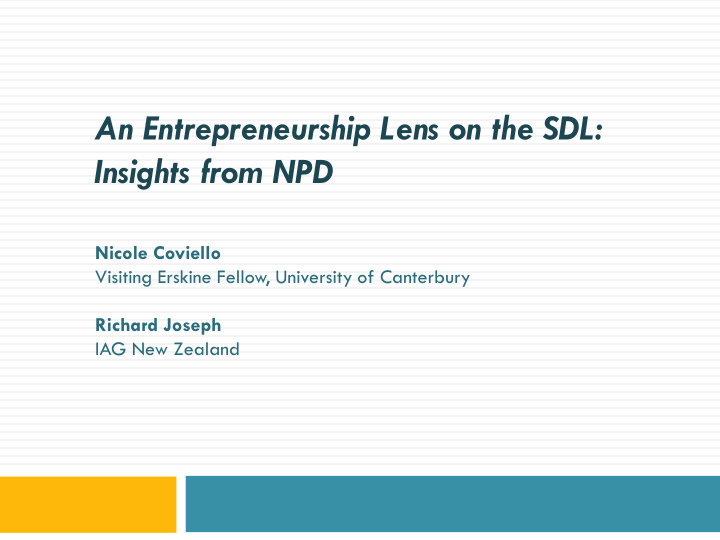



An Entrepreneurship Lens on the SDL: Insights from NPD Nicole Coviello Visiting Erskine Fellow, University of Canterbury Richard Joseph IAG New Zealand
What we know about customers in NPD? Customer involvement is central to NPD success (Rothwell et al 1974; Cooper 1979; Cooper and Kleinschmidt 1987) Customer orientation can positively influence NPD outcomes (Li and Calantone 1998; Lukas and Ferrell 2000) Customer-driven development influences quality of NPD effort (Ramaswami, Srivastava and Bhargava 2009) Various mechanisms to hear the ‘ voice of the customer ’ (Griffin and Hauser 1993; Leonard and Rayport 1997, etc.) Role of ‘ lead users ’ (von Hippel 1986; Lilien et al 2002) .... Customers are the ‘inside track’ to innovation (Penrose 1959)
What we don’t know? The NPD literature tends to focus on mechanisms to involve the customer or the types of customer relevant to NPD or when customers might be involved during NPD Inconsistent results Lack of an integrated account of how, when and which customers participate in NPD
Our perspective? Customers (existing or potential) are a market-based asset (Srivastava, Shervani and Fahey 1998; 1999; Gruner and Homburg 2000; Fang 2008) We investigate: how customers participate in NPD, when this occurs, and which customers participate.
The setting Smaller and newer B2B markets Really new products (aka major innovation or MI) Each MI involves non-customized Information and Communication Technology (ICT) equipment ICT experiences uncertainty and rapid change, with new ideas made possible through technological breakthroughs.
General results NPD for MI in smaller and newer firms is stream-lined, fluid Customers can be defined in a variety of ways; many different forms of customer might be involved with NPD In the same way that customers come in different forms, they can take different roles through NPD (both proactive and reactive) Beyond customers, there are many other types of actors, all in the firm’s network... all are ‘resource integrators’
Effectuation logic (Sarasvathy 2001) Successful firms did ‘development deals’, made on the basis of affordable loss Successful firms leveraged existing and potential customer relationships in different ways Opportunity surfaces as a relatively unformed idea Through working with customers, the opportunity is co-created Risk is shared by both parties
Limitations and implications Focus on internal informants (no customers included) Analysis of selected dyads appropriate for study on (e.g.) co-learning, co-creation, or the study of how firms manage uncertainty in asymmetric relationships Small firms in NZ (and not all the same size) Basis for study with larger firms and across other institutional contexts Successes/failures not embedded in same firms Ideal, but a practical challenge
Recommend
More recommend